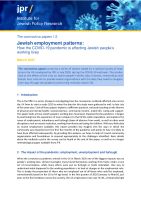Jewish employment patterns: How the COVID-19 pandemic is affecting Jewish people’s working lives
Author(s)
Publication Date
16 March 2021
Publication Place
Publisher
Abstract
As soon as the seriousness of the COVID-19 pandemic became evident, concern began to be expressed in the Jewish community about how its effects might damage different aspects of Jewish life. Our July 2020 survey of Jews across the UK was designed to investigate some of these effects and bring some data into policy discussion about the future of the community.
In this fifth paper drawing on those survey data, we examine the impact of the pandemic on the working lives of Jewish people in the United Kingdom. It begins by studying how the experience of Jews compares to that of the wider population, and explores the issues of employment, redundancy and furlough, as well as other work disruptions such as income reduction, working from home, and caring for children. With very little data on Jewish employment available, this report provides key insights into the ways in which the community was impacted over the first five months of the pandemic, and points to how it is likely to have been affected subsequently. By providing this analysis, we hope to help UK Jewish community organisations and foundations to respond appropriately to the challenges identified.
Of particular note among the findings: the Jewish employment rate had declined at a lower rate than among the general population, but the Jewish unemployment rate had increased at a higher rate. Whilst many Jews have experienced serious work impacts, and many among the high proportions of self-employed Jews have lost income without having the same access to government financial support as the employed, it seems unlikely that the Jewish population as a whole has suffered disproportionately. We found that those who were most likely to experience severe work disruptions (defined as being made redundant, being furloughed, having their pay reduced and/or having their hours reduced) were the youngest workers (aged 16-24), Jewish women (especially regarding furlough and redundancy), single parents, those with household incomes below £30,000 per year prior to the pandemic, and the most religious respondents, especially Strictly Orthodox workers, more than half of whom (52%) experienced one or more of these severe impacts.
A follow-up survey planned for the coming months will determine how things have changed further since July among Jews, but it is nevertheless already clear that communal investment in employment support is needed, since all national indicators tell us that the employment situation has generally deteriorated since that time. Continued monitoring of Jewish employment rates is imperative if we are to determine and understand how the overall picture is changing and whether various endeavours being undertaken to address the challenges are effective. This will require a combination of continued investigations using data gathered within the community, as well as new investments in analysing and interpreting national data sources to shed light on long-term trends.
In this fifth paper drawing on those survey data, we examine the impact of the pandemic on the working lives of Jewish people in the United Kingdom. It begins by studying how the experience of Jews compares to that of the wider population, and explores the issues of employment, redundancy and furlough, as well as other work disruptions such as income reduction, working from home, and caring for children. With very little data on Jewish employment available, this report provides key insights into the ways in which the community was impacted over the first five months of the pandemic, and points to how it is likely to have been affected subsequently. By providing this analysis, we hope to help UK Jewish community organisations and foundations to respond appropriately to the challenges identified.
Of particular note among the findings: the Jewish employment rate had declined at a lower rate than among the general population, but the Jewish unemployment rate had increased at a higher rate. Whilst many Jews have experienced serious work impacts, and many among the high proportions of self-employed Jews have lost income without having the same access to government financial support as the employed, it seems unlikely that the Jewish population as a whole has suffered disproportionately. We found that those who were most likely to experience severe work disruptions (defined as being made redundant, being furloughed, having their pay reduced and/or having their hours reduced) were the youngest workers (aged 16-24), Jewish women (especially regarding furlough and redundancy), single parents, those with household incomes below £30,000 per year prior to the pandemic, and the most religious respondents, especially Strictly Orthodox workers, more than half of whom (52%) experienced one or more of these severe impacts.
A follow-up survey planned for the coming months will determine how things have changed further since July among Jews, but it is nevertheless already clear that communal investment in employment support is needed, since all national indicators tell us that the employment situation has generally deteriorated since that time. Continued monitoring of Jewish employment rates is imperative if we are to determine and understand how the overall picture is changing and whether various endeavours being undertaken to address the challenges are effective. This will require a combination of continued investigations using data gathered within the community, as well as new investments in analysing and interpreting national data sources to shed light on long-term trends.
Topics
Genre
Geographic Coverage
Original Language
Series Title
Series Number
1.5
Link
Download can be found on page, Jewish employment patterns: How the COVID-19 pandemic is affecting Jewish people’s working lives
Bibliographic Information
Jewish employment patterns: How the COVID-19 pandemic is affecting Jewish people’s working lives. . 16 March 2021: https://archive.jpr.org.uk/object-1783




